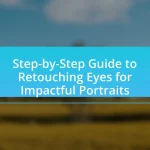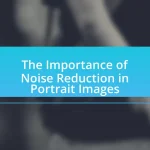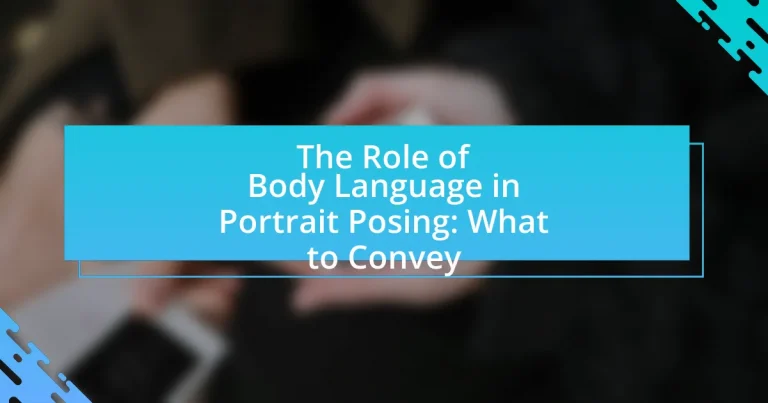The article focuses on the critical role of body language in portrait posing, emphasizing how it conveys emotions, personality, and the intended message of a photograph. It explores the influence of posture, facial expressions, and hand positioning on viewer perception, highlighting that effective body language can enhance the emotional impact of portraits. Additionally, the article discusses common mistakes photographers make regarding body language, techniques for directing poses, and strategies to create a relaxed atmosphere for subjects, ultimately underscoring the importance of non-verbal communication in portrait photography.
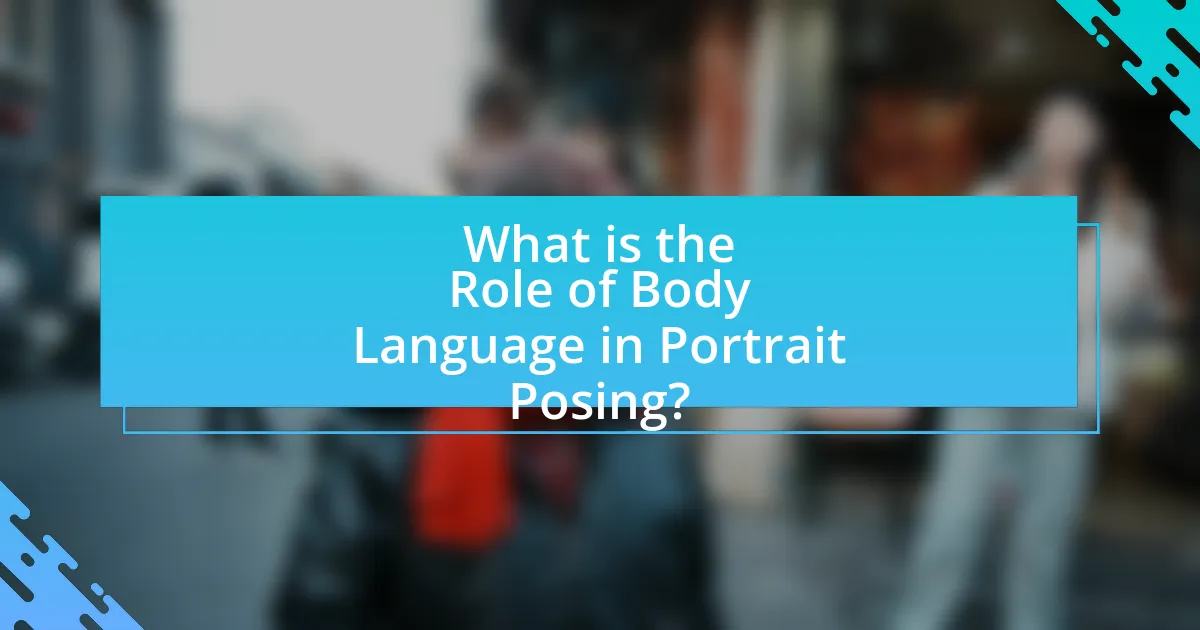
What is the Role of Body Language in Portrait Posing?
Body language plays a crucial role in portrait posing by conveying emotions, personality, and the intended message of the photograph. Effective body language can enhance the subject’s expression, create a connection with the viewer, and influence the overall mood of the portrait. For instance, open postures, such as uncrossed arms and relaxed shoulders, typically suggest confidence and approachability, while closed postures may indicate discomfort or defensiveness. Research in nonverbal communication supports this, showing that body language significantly impacts how individuals are perceived in visual media, reinforcing the importance of intentional posing in portrait photography.
How does body language influence the perception of a portrait?
Body language significantly influences the perception of a portrait by conveying emotions, intentions, and personality traits of the subject. For instance, an open posture with relaxed arms can suggest confidence and approachability, while crossed arms may indicate defensiveness or discomfort. Research indicates that viewers often interpret these non-verbal cues instinctively, impacting their emotional response to the artwork. A study published in the journal “Psychological Science” by researchers at the University of California found that body language can alter the viewer’s interpretation of a subject’s mood and character, demonstrating that the subtleties of posture and gesture are crucial in shaping the overall impression of a portrait.
What specific emotions can body language convey in a portrait?
Body language in a portrait can convey specific emotions such as happiness, sadness, anger, surprise, and confidence. For instance, a smile and open posture typically indicate happiness, while crossed arms and a frown may suggest anger or defensiveness. Research in nonverbal communication shows that facial expressions and body positioning are critical in interpreting emotions; for example, a study by Ekman and Friesen (1971) demonstrated that certain facial cues are universally recognized as indicators of specific feelings. Thus, the arrangement of limbs, facial expressions, and overall posture in a portrait can effectively communicate a wide range of emotional states.
How does posture affect the overall message of a portrait?
Posture significantly influences the overall message of a portrait by conveying emotions, attitudes, and social status. For instance, an upright posture often communicates confidence and authority, while a slouched posture may suggest insecurity or vulnerability. Research indicates that body language, including posture, accounts for a substantial portion of non-verbal communication, impacting how viewers interpret the subject’s personality and intentions. A study published in the Journal of Nonverbal Behavior by Burgoon et al. (2016) highlights that specific postures can evoke distinct emotional responses in observers, reinforcing the idea that posture is a critical element in shaping the narrative of a portrait.
Why is understanding body language important for photographers?
Understanding body language is crucial for photographers because it enables them to capture authentic emotions and interactions in their subjects. By interpreting non-verbal cues, photographers can direct poses that reflect genuine feelings, enhancing the overall impact of the portrait. Research indicates that approximately 93% of communication is non-verbal, highlighting the significance of body language in conveying mood and personality. This understanding allows photographers to create more compelling images that resonate with viewers, ultimately improving the effectiveness of their work.
How can photographers use body language to enhance their work?
Photographers can enhance their work by effectively utilizing body language to convey emotions and narratives in their portraits. By directing subjects to adopt specific poses and gestures, photographers can evoke feelings such as confidence, vulnerability, or joy, which significantly impact the viewer’s perception. Research indicates that nonverbal cues, including posture and facial expressions, account for a substantial portion of communication, with studies showing that up to 93% of communication effectiveness is derived from nonverbal elements (Mehrabian, 1971). Therefore, when photographers guide subjects to express authentic body language, they create more engaging and relatable images that resonate with audiences.
What are common mistakes photographers make regarding body language?
Common mistakes photographers make regarding body language include failing to direct their subjects effectively, which can lead to stiff or unnatural poses. Photographers often overlook the importance of creating a relaxed atmosphere, resulting in tense expressions and closed body language. Additionally, they may neglect to consider the positioning of limbs, which can create unflattering angles or convey unintended emotions. Research indicates that body language significantly impacts viewer perception, emphasizing the need for photographers to be mindful of these elements to enhance the overall quality of their portraits.
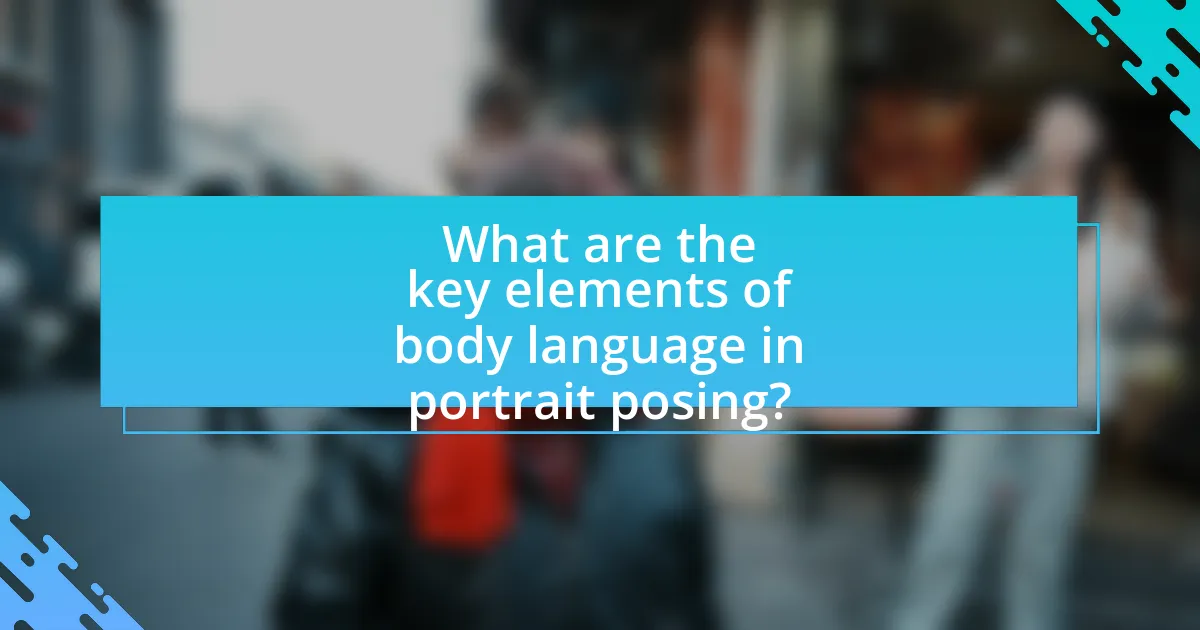
What are the key elements of body language in portrait posing?
The key elements of body language in portrait posing include posture, facial expressions, hand positioning, and body orientation. Posture conveys confidence or vulnerability; for instance, an upright stance suggests confidence, while slouched shoulders may indicate insecurity. Facial expressions are crucial for conveying emotions, with a genuine smile often creating a warm connection with the viewer. Hand positioning can enhance or detract from the overall message; relaxed hands can suggest ease, while tense hands may imply discomfort. Body orientation, such as angling the body towards or away from the camera, influences the perceived engagement and openness of the subject. These elements work together to communicate the intended message of the portrait effectively.
How do facial expressions contribute to body language in portraits?
Facial expressions significantly enhance body language in portraits by conveying emotions and intentions that complement physical posture. For instance, a smile can indicate warmth and approachability, while a frown may suggest sadness or disapproval. Research shows that facial expressions can account for up to 55% of emotional communication, as highlighted in studies by Paul Ekman, a leading psychologist in the field of emotions. This interplay between facial expressions and body language creates a cohesive narrative in portraits, allowing viewers to interpret the subject’s feelings and personality more accurately.
What are the most effective facial expressions for different moods?
The most effective facial expressions for different moods include a smile for happiness, a frown for sadness, raised eyebrows for surprise, and a furrowed brow for anger. These expressions are universally recognized and convey clear emotional states. Research by Paul Ekman, a psychologist known for his work on emotions and facial expressions, demonstrates that these expressions are consistent across cultures, indicating their effectiveness in communicating specific moods. For instance, a smile activates the zygomatic major muscle, signaling joy, while a frown engages the corrugator supercilii muscle, indicating distress.
How can subtle changes in expression alter the portrait’s impact?
Subtle changes in expression can significantly alter a portrait’s impact by influencing the viewer’s emotional response and interpretation of the subject. For instance, a slight shift from a neutral expression to a smile can evoke feelings of warmth and approachability, while a frown may convey sadness or contemplation. Research indicates that facial expressions are crucial in nonverbal communication, with studies showing that 55% of emotional impact comes from facial cues (Mehrabian, 1971). Therefore, even minor adjustments in expression can lead to vastly different perceptions of the subject’s personality and mood, ultimately shaping the overall effectiveness of the portrait.
What role does posture play in conveying messages through portraits?
Posture plays a crucial role in conveying messages through portraits by influencing the viewer’s perception of the subject’s emotions, intentions, and personality. For instance, an upright posture often signifies confidence and authority, while a slouched posture may suggest insecurity or vulnerability. Research in nonverbal communication indicates that body language, including posture, can significantly impact how individuals interpret visual cues; studies show that 55% of communication is nonverbal, highlighting the importance of posture in visual representation. Thus, the way a subject holds their body in a portrait can effectively communicate complex emotional states and social dynamics to the audience.
How can different postures change the viewer’s interpretation?
Different postures can significantly alter a viewer’s interpretation by conveying distinct emotional states and intentions. For instance, an open posture, characterized by uncrossed arms and legs, typically signals confidence and approachability, leading viewers to perceive the subject as friendly or trustworthy. Conversely, a closed posture, such as crossed arms or a hunched back, often suggests defensiveness or discomfort, prompting viewers to interpret the subject as unapproachable or anxious. Research by Burgoon et al. (2016) in “Nonverbal Communication” highlights that body language, including posture, plays a crucial role in interpersonal communication, influencing how individuals are perceived in social contexts. Thus, the specific posture adopted can shape the emotional narrative conveyed to the viewer, impacting their overall interpretation of the subject.
What are the best postures for various themes in portrait photography?
The best postures for various themes in portrait photography include relaxed stances for casual themes, formal poses for professional settings, and dynamic angles for creative expressions. For casual themes, subjects should adopt a relaxed posture with slightly bent arms and legs to convey comfort and approachability. In formal settings, straightened backs, squared shoulders, and hands clasped or placed at the sides project confidence and professionalism. For creative themes, using dynamic angles, such as tilting the head or shifting weight to one leg, can evoke energy and spontaneity. These postures align with the intended emotional conveyance of each theme, enhancing the overall impact of the portrait.
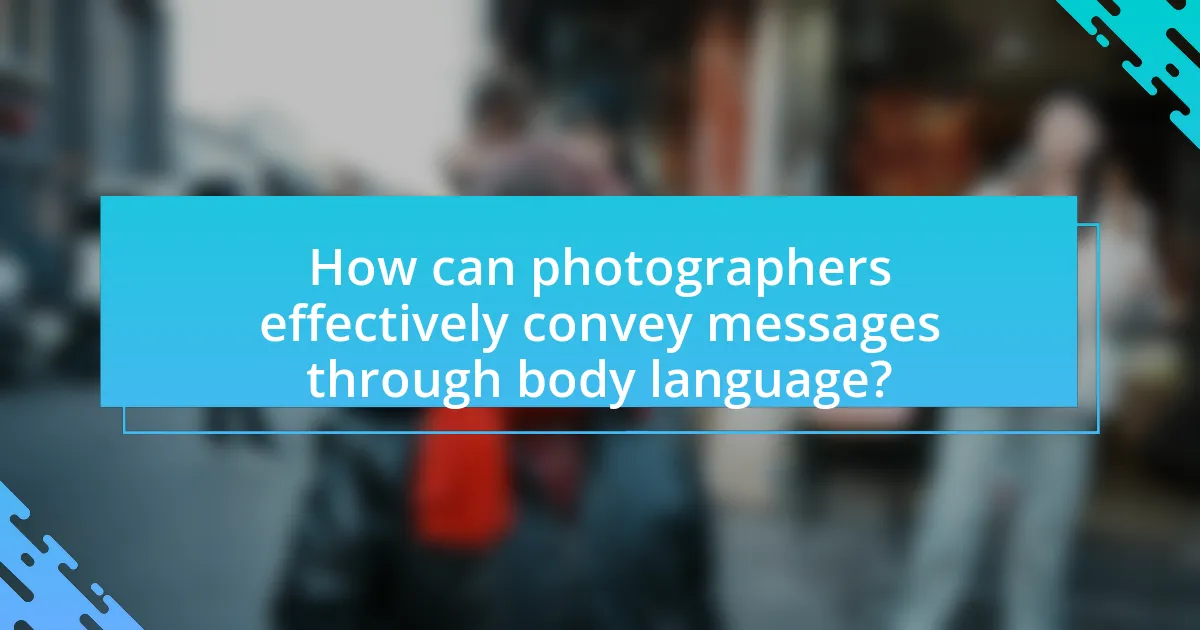
How can photographers effectively convey messages through body language?
Photographers can effectively convey messages through body language by carefully directing poses and expressions that reflect the intended emotion or narrative. For instance, open body positions, such as uncrossed arms and relaxed shoulders, typically communicate confidence and approachability, while closed positions can suggest defensiveness or discomfort. Research indicates that nonverbal cues, including posture and facial expressions, significantly influence viewer perception, as demonstrated in studies on emotional communication in photography. By understanding these dynamics, photographers can manipulate body language to enhance storytelling and emotional resonance in their portraits.
What techniques can be used to direct body language during a shoot?
To direct body language during a shoot, photographers can employ techniques such as verbal cues, physical guidance, and demonstrating poses. Verbal cues involve giving clear instructions on how to position the body, which helps subjects understand the desired posture. Physical guidance includes gently adjusting the subject’s limbs or torso to achieve the intended look, ensuring that the body language aligns with the shoot’s theme. Demonstrating poses allows the photographer to visually communicate the desired body language, making it easier for the subject to replicate. These techniques are effective because they create a clear framework for the subject to follow, enhancing the overall quality of the portrait.
How can verbal cues influence body language in subjects?
Verbal cues can significantly influence body language in subjects by providing context and emotional direction that shape their nonverbal expressions. When a speaker uses specific words or tones, subjects often subconsciously adjust their posture, facial expressions, and gestures to align with the conveyed message. For instance, research indicates that positive verbal reinforcement can lead to open body language, such as uncrossed arms and relaxed posture, while negative cues may result in closed-off stances, like crossed arms or avoidance of eye contact. This phenomenon is supported by studies in communication psychology, which demonstrate that verbal messages can prime individuals to exhibit corresponding nonverbal behaviors, thereby enhancing or diminishing the intended emotional impact of the interaction.
What are some non-verbal cues photographers can use to guide subjects?
Photographers can use several non-verbal cues to guide subjects effectively. These cues include hand gestures, facial expressions, body positioning, and eye contact. For instance, a photographer may use a thumbs-up gesture to indicate approval or a gentle wave of the hand to direct a subject’s movement. Additionally, maintaining eye contact can create a connection and encourage subjects to relax, while specific body positioning, such as tilting the head or shifting shoulders, can help convey desired emotions or poses. Research indicates that non-verbal communication significantly influences interpersonal interactions, making these cues essential for achieving the intended outcome in portrait photography.
What are the best practices for posing subjects to convey specific emotions?
To effectively pose subjects for conveying specific emotions, photographers should focus on body language, facial expressions, and positioning. For instance, to express happiness, subjects can be posed with open body language, such as arms wide and a genuine smile, which has been shown to elicit positive feelings in viewers. Conversely, to convey sadness, subjects should adopt closed body language, such as slumped shoulders and downturned faces, which research indicates can evoke empathy and understanding from the audience. Additionally, the angle of the subject’s head can influence emotional perception; tilting the head slightly can create a sense of vulnerability, enhancing the emotional impact. These practices are supported by studies in psychology that demonstrate how nonverbal cues significantly affect emotional interpretation in visual media.
How can a photographer create a relaxed atmosphere for natural poses?
A photographer can create a relaxed atmosphere for natural poses by establishing a comfortable environment and engaging with the subjects. This can be achieved through friendly conversation, playing music, and allowing subjects to move freely, which helps reduce tension. Research indicates that a relaxed setting can lead to more authentic expressions and poses, as subjects feel less pressured and more at ease. For instance, a study published in the Journal of Visual Communication in Medicine highlights that positive interactions between photographers and subjects significantly enhance the quality of portraits by fostering genuine emotions.
What tips can help subjects feel comfortable and express genuine emotions?
To help subjects feel comfortable and express genuine emotions, creating a relaxed environment is essential. This can be achieved by establishing rapport through friendly conversation, ensuring the setting is familiar or comfortable, and using positive body language, such as maintaining eye contact and smiling. Research indicates that subjects are more likely to open up when they feel safe and understood, as demonstrated in studies on interpersonal communication, which show that nonverbal cues significantly influence emotional expression.
What common challenges do photographers face with body language in portraits?
Photographers commonly face challenges in capturing authentic body language in portraits, which can lead to unflattering or stiff images. One significant challenge is the subject’s self-consciousness, often resulting in forced poses that lack natural expression. Additionally, miscommunication between the photographer and the subject can lead to misunderstandings about the desired mood or emotion, causing awkward body language. Research indicates that body language accounts for a substantial portion of non-verbal communication, emphasizing the importance of relaxed and genuine poses to convey the intended message effectively.
How can photographers overcome issues with stiff or unnatural poses?
Photographers can overcome issues with stiff or unnatural poses by encouraging natural movement and interaction among subjects. Techniques such as engaging in conversation, using humor, and incorporating prompts that require action can help subjects feel more relaxed and authentic. Research indicates that relaxed subjects produce more genuine expressions and body language, which enhances the overall quality of the portrait. For instance, a study published in the Journal of Visual Communication in Medicine found that subjects who were prompted to engage in light-hearted activities exhibited significantly more natural poses compared to those who were instructed to hold still.
What strategies can be employed to improve communication with subjects?
To improve communication with subjects, photographers can employ strategies such as active listening, clear verbal instructions, and non-verbal cues. Active listening involves fully engaging with the subject’s responses and emotions, which fosters trust and openness. Clear verbal instructions help subjects understand what is expected of them, reducing anxiety and enhancing their comfort level. Non-verbal cues, such as maintaining eye contact and using positive body language, reinforce the message being conveyed and create a more relaxed atmosphere. Research indicates that effective communication significantly enhances the quality of portrait outcomes, as subjects feel more at ease and confident during the session.
What practical tips can enhance the role of body language in portrait posing?
To enhance the role of body language in portrait posing, subjects should focus on their posture, facial expressions, and hand positioning. Good posture, such as standing tall with shoulders back, conveys confidence and engagement, while relaxed facial expressions can create a more approachable and authentic image. Additionally, using hands purposefully—such as placing them on hips or gently touching the face—can add interest and convey emotion. Research indicates that body language significantly impacts perception; for instance, a study published in the Journal of Nonverbal Behavior found that open body language increases likability and trustworthiness in photographs.




